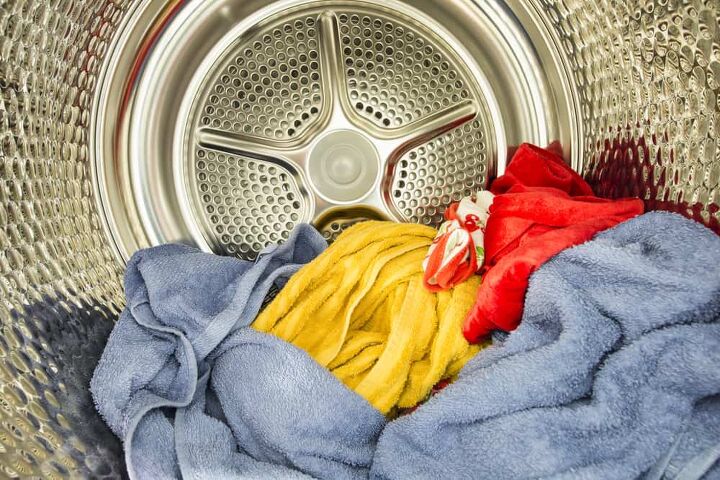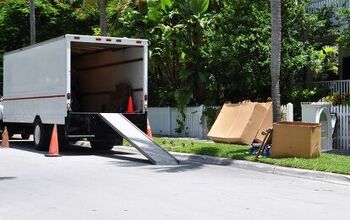Dryer Making A Loud Screeching Sound When Turning? (Try This!)

Your dryer is one appliance that is in use nearly every day, so you become accustomed to the sound of it running. So, if there is something wrong with it, you’ll most likely catch it because it won’t sound the way it usually does. It’ll have an odd screech to it, which could be loud or quiet, depending on the problem.
In most cases, a faulty idler pulley is the culprit of a dryer making loud screeching noises when turning. Unplug your dryer and remove the belt. Pull the pulley and if you cannot turn it manually, replace the parts. Damaged parts like drum bearings, the motor, or the drum support may be to blame as well.
This article will talk about these seven parts of your dryer that could be causing the screeching and explain how you can inspect each component. That way, you don’t need to hire a professional to diagnose it.
Do You Need Appliance Repair Services?
Get free, zero-commitment quotes from pro contractors near you.

Drum Bearings
In specific gas and electric dryer models, a bearing at the rear holds the drum in place. This could either be a ball and socket or possibly a shaft joined to a sleeve blushing.
If this rear bearing produces the screeching noise, it is defective, and a replacement will be required.
Inspect The Drum Bearings
- Check for residual water in the drum. Disconnect your dryer from the power supply and make sure there is no clothing or residual water in the drum.
- Spin your drum. Do this manually while you listen for any odd noises.
- Move your drum. Hold the drum’s front edge, and move it up towards you and toward the back of the dryer in one swoop.
- Replace the drum bearing. If it’s easy to move your drum in any direction, you will need to replace the drum bearing.
Drum Support Rollers & Shaft
Rollers hold the drum of a specific gas and electric dryer models. These are usually situated on the rear bulkhead, although in particular models, you’ll find them on the front bulkhead.
With usage over time, the rollers wear out, which is why the dryer’s drum can’t turn easily. This causes a screeching or, in some instances, a heavy knocking sound. If this is happening, the drum rollers should be replaced together.
Check Your Drum Support Rollers
- Remove the drum. Disconnect your dryer from the power and on the cabinet to remove the drum.
- Look for signs of damage. Check the drum for any signs of wear or damage.
- Replace the drum support rollers. If you see that one roller is worn out or damaged, you will need to replace it.
Drive Belt
Both gas and electric dryers use belts to turn the drum of the dryer. These tend to get harder and more brittle as they age. Individual sections of the belt may come away when the drum rotates, creating a heavy knocking sound.
Inspect The Drive Belt
- Check that the drum is empty. Also, you will want to disconnect your dryer from the power.
- Locate the drive belt. Take off the front panel and look for the drive belt. It will be wrapped around the drum under your idler pulley wheel.
- Inspect your belt. Look for signs of cracking, fraying, or burning.
- Replace your drive belt. If you notice any signs of damage, you will need to replace your drive belt.
Idler Pulley
A dryer’s idler pulley is used to keep the drum belt tight so that it doesn’t onto the drive motor pulley or the drum itself when the dryer is fully loaded and operational. This pulley turns at high speeds so that it can break as a result of the constant friction. This can result in a squeaking or screeching sound, or even a scraping or heavy knocking sound.
Check The Idler Pulley
- Remove the front panel. Disconnect your dryer its power. You will then need to remove the front panel. In some models, this will be the lower access panel. Also, ensure your dryer is empty.
- Inspect the idler pulley. Remove the drive belt. You will need to softly push the idler pulley in the motor’s direction to release the tension. After this, you can slide it off.
- Pull off the idler pulley. This should be easy and should have little to no resistance. If you have a hard time pulling this off, then you will most likely need a replacement.
- Check the shaft. Look for signs of damage on the shaft. You can also take this opportunity to inspect the idler pulley closer.
- Replace the pulley. Upon finding any signs of damage or wear on the pulley or shaft, you will need to replace the idler pulley.
Blower Wheel & Housing
In gas and electric dryers, the blower wheel pulls air from the heating chamber. This passes through the drum itself and exits via the exhaust vent. As the blower wheel is plastic, it can wear out in time.
Usually connected to the motor’s end, it can be threaded on the shaft or secured by a clamp. If the blower wheel comes loose, a loud heavy knocking or even a roaring sound are typical signs.
Inspecting A Blower Wheel
- Locate the blower wheel. Unplug your dryer and remove the back panel. Usually, the rear panel can be found in the bottom left corner, under here is where you’ll find the blower wheel.
- Inspect the blower wheel and housing. Look for any signs of damage. Make sure to look for any foreign objects around the blower wheel, which could cause the noise.
- Inspect the hub wheel. Remove the front panel of your dryer. You will then need to remove the drum as well. Look at the hub for any signs of damage.
- Replace the blower wheel. If there are any signs of damage on either the hub or wheel, you will need to replace the blower wheel.
Baffle Or Lifter
Baffles or lifters are situated on the drum’s interior surface, and they tumble the clothes in the dryer. If one becomes detached, the result is a heavy knocking or banging noise. It will break off completely in due course.
Check The Baffle
- Inspect the baffles. Open the door and look for any signs of cracking or damage on your baffles.
- Check for loose change. Look for any change or metal that has lodged itself under the baffles. This can cause rattling noises and damage your clothing.
- Replace the baffles. If you discover any damage or the baffles feel loose, they will need to be replaced.
Motor
All dryers use a motor to rotate the blower and the drum. When the motor is faulty, it may produce various sounds. A loose pulley will make a rattling sound; a faulty bearing will create a high pitched noise, and a defective winding or switch will produce a humming sound.
Test A Dryer Motor
- Unplug your dryer. Open the cabinet and locate the motor. You might have to remove the drum or blower wheel to get to your motor.
- Disconnect the wire leads. You will need to remove the motor, but the leads need to be removed from the wiring harness to do this.
- Use your multimeter. Set your multimeter to Rx1 and touch the probes to the terminals. The reading should either be close to zero or zero.
- Check the ground connection. Place a probe on the motor’s metal housing and place the other one onto each of the terminals. Do this one at a time, though. This should produce no reading.
- Replace the motor. If the tests fail, you will need to replace the motor for your dryer.
Related Questions
On average, most people pay between $100 to $400 to fix a squeaky dryer. This covers mostly drum issues, like a broken belt or clogged vents.
If an appliance repair costs more than half of the replacement cost, it’s better to buy a new dryer. A basic dryer will cost you about $300.
Do You Need Appliance Repair Services?
Get free, zero-commitment quotes from pro contractors near you.

In Summary

Heather is a passionate writer who loves anything DIY. Growing up, she learned everything from home repairs to design, and wants to share her tips with you. When she's not writing, she's usually hiking or searching for her next DIY project.
More by Heather Robbins













![The 5 Best Angle Grinders – [2022 Reviews & Buyer's Guide]](https://cdn-fastly.upgradedhome.com/media/2023/07/31/9071326/the-5-best-angle-grinders-2022-reviews-buyer-s-guide.jpg?size=350x220)













